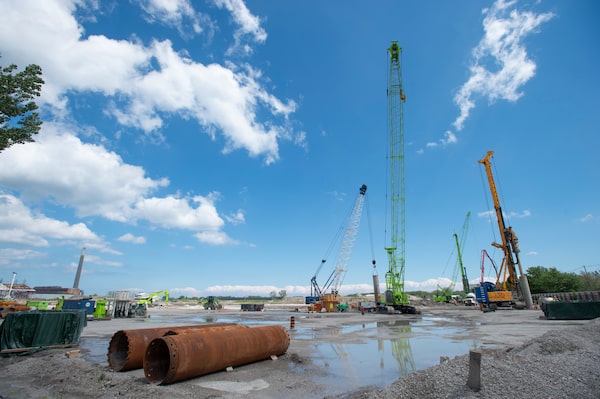
Toronto's Port Lands area on June 25, 2019. The city faces a second housing crisis: a dire shortage of suitable space for growth of manufacturing, logistics and other critical industries.Andrew Lahodynskyj/The Canadian Press
Giles Gherson is the president and chief executive officer of the Toronto Region Board of Trade.
The Toronto region stands at the edge of two crises. The first is well understood and visible. We are grappling with a rapidly growing population and nowhere near enough homes. The second crisis is not so pronounced but no less a threat: Toronto faces a dire shortage of suitable space for business growth, particularly for manufacturing, logistics and other critical industries.
Few are talking about it, and that’s a huge problem. Earlier this year, the Ontario government announced new policies to address the housing crisis. While the changes are primarily designed to increase housing supply, some significantly weaken protections for critical employment lands. The Toronto Region Board of Trade’s recently released “Race for Space” report identified at least 715 housing conversion requests on employment lands in the region, underscoring the threat of encroachment in these zones.
The provincial government has been investing heavily in reindustrializing Ontario after decades of underinvestment. But for this policy to be successful, land has to be made available.
This fact has long been recognized. In 2019, the government introduced 31 “provincially significant employment zones” (PSEZ) to limit the growing pressure from conversions. Employment lands are provincially and municipally protected areas zoned for industrial, commercial, institutional and office uses.
Such lands do not allow for housing precisely because they were developed to protect intensive industries such as manufacturing and distribution. These lands are a key driver of our economy, supporting more than 1.5 million jobs in the region.
Now, by weakening protections for such lands, the recent regulatory change effectively eliminates PSEZs.
The impact of that cannot be overstated. Businesses in the goods production and distribution sector require vast amounts of land close to markets, talent and transportation. The GTA West Economic Gateway, a geographic area centred on Toronto Pearson International Airport, contains the largest PSEZ in the region. It’s home to a significant portion of Ontario’s logistics, transportation and manufacturing sectors.
Ontario’s regulatory change will exacerbate an already bad situation. Many businesses in this area have shared their struggles to grow and invest because the price of available industrial land continues to skyrocket. It’s no surprise – scarcity drives up prices. It also drives businesses to other jurisdictions, including the United States, taking our high-paying jobs with them and negatively affecting our region’s competitiveness.
We must safeguard our employment lands, and to do so, it is imperative that we first ensure the necessary policy and regulatory protections are in place. These could include steps such as formalizing buffer and transition zones for all employment lands, which protect residential neighbourhoods.
Secondly, a regional inventory of employment lands could be created as the foundation of a comprehensive employment and industrial lands strategy. Furthermore, a holistic decision-making process should be implemented, building on the existing Municipal Comprehensive Review, to rigorously analyze the cumulative economic impact of conversion proposals and identify where housing can strategically be located on employment lands.
The right thing to do is not always the easy thing to do. While it’s encouraging to see the government taking action to address the housing crisis, we must not forget the pressing needs of businesses and the role that manufacturing and distribution has in our economy.
We must find the right balance between housing supply and land for industry, for the well-being of our communities and the health of our economy, because if the lands go, so will the jobs.